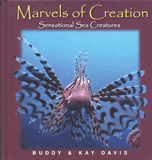News to Note, January 13, 2007
A weekly feature examining news from the biblical viewpoint
1. Mustard Plant Adaptation: Evolution or Selection?
Out-of-control weeds sprouting from an “evolution explosion”: the plot of a late-night thriller or hot news? It’s the latter according to US scientists, reports Sydney’s Herald: “Fast-growing weeds have evolved over a few generations to adapt to climate change … [t]he weeds will likely keep up with any attempts to develop crops that can adapt to global warming.”
2. National Geographic News: “Bizarre New Form of Life Found in Arctic Ocean, Scientists Announce“
National Geographic News reports an exciting, historic discovery in the Arctic Ocean: “[a]n entirely new group of tiny and bizarre marine algae.” It seems a team of European scientists stumbled upon the microscopic life “while analyzing DNA sequences in samples of seawater.” The organisms, which are fluorescent, have been named “picobiliphytes.”
What’s interesting is that this article emphasizes the distinctiveness of the picobiliphytes. Fabrice Not, a marine biologist member of the team that discovered the picobiliphytes, explains that “[t]hese organisms represent a new evolutionary lineage … [t]he discovery didn't provide any sister relationship to any other groups of organisms known to date … the divergence of this group from known organisms is as great as the difference between land plants and animals.” In other words, this organism is truly dissimilar to other categories of life (animals, plants, and other eukaryotes; bacteria; archaea). Yet one of the most common arguments given for an evolutionary explanation of life is the inherent connectedness of life on the purported evolutionary tree. A salient example of this is, of course, comparison of ape and human anatomy. “We’re so similar,” the argument goes, “and why would a designer make such similarity just to confuse us?” But when groups of life entirely unique are found-such as these picobiliphytes-the secular commentary is ironic, yet unsurprising: evolution, evolution, evolution.3. PhysOrg.com: “New findings blow a decade of assumptions out of the water“
The topic of this article-oceanic nitrogen fixation-is not directly related to the creation/evolution debate. Yet the headline highlights the important role assumptions play in how we form beliefs. See if you can apply phrases such as “because it has been thought that” and “the conventional wisdom for the past decade dictated” to the creation/evolution debate and recall the many scientists who reject creation a priori by explaining that, for example, “surely God wouldn’t have done in that way” or by simply declaring that it is unscientific to believe in a god, period.
And of course, these frequent changes in scientific theory force one to wonder: is there anything man has to say that is fully trustworthy, or should we be taking the Word of Someone else?4. PhysOrg.com: “Modern man’s footprint in Europe dates back 45,000 years“
“Well the Bible surely can’t be right; scientists are examining things 45,000 years old!” some casual readers might be prone to thinking. This article, though on a completely different topic, goes hand-in-hand philosophically with the article referenced in item #3. In item #3, scientists’ assumptions-and former conclusions-have been overturned by the “latest” science. When such an overturn happens, the old theories and assumptions often become laughable. Yet before they are overturned, it is usually forbidden to even question them.
So it is with the dating of “man’s footprint,” as this article figuratively puts it. Authoritatively stating, “Modern man's presence in Europe stretches back some 45,000 years, a team of international researchers reported,” the article proceeds to quote no statements in support of such a date (other than that the set of archaeological sites in question has yielded material of similar age in the past-circular reasoning at its finest). Rather, the article intriguingly describes archaeological finds at the site, located along the Don River in Russia: perforated shell ornaments and a carved piece of ivory (thought to be the head of a small human figurine) that may “represent the earliest known piece of figurative art in the world.” Yet shell ornaments and ivory figurines are still made today (albeit rarely and often illegally, in the case of the latter). So how do these scientists know they’re 45,000 years old? Assumptions Radiometric Dating.
5. Monkeys Demonstrate Reflexive Adaptability
This light-hearted application of evolutionary theory aims to explain why it’s a challenge to consistently hit “picture-perfect drives” down the fairway (or repeat your best performance in nearly any sport or physical challenge). Stanford researchers trained rhesus monkeys to reach for different-colored spots at different speeds (red fast, green slow), then analyzed their success at repeatedly reaching for the red at the same speed, and repeatedly reaching for the green at the same speed. But the monkeys’ speed varied-as did their brain activity during the process.
Remember, if you see a news story that might merit some attention, let us know about it! And thanks to all of our readers who have submitted great news tips to us. If you didn’t catch last week’s News to Note, why not take a look at it now? See you next week!
Recommended Resources

Answers in Genesis is an apologetics ministry, dedicated to helping Christians defend their faith and proclaim the good news of Jesus Christ.
- Customer Service 800.778.3390
- © 2024 Answers in Genesis


